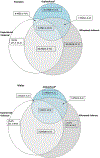Prevalence of Adverse Childhood Experiences in sub-Saharan Africa: A multicountry analysis of the Violence Against Children and Youth Surveys (VACS)
- PMID: 37482505
- PMCID: PMC11330677
- DOI: 10.1016/j.chiabu.2023.106353
Prevalence of Adverse Childhood Experiences in sub-Saharan Africa: A multicountry analysis of the Violence Against Children and Youth Surveys (VACS)
Abstract
Background: Adverse Childhood Experiences are traumatic events early in life and have been associated with significant negative health outcomes.
Objective: To estimate the prevalence of ACEs in five low- and middle-income sub-Saharan African countries.
Participants and setting: Nationally representative data from the Cote d'Ivoire (2018), Kenya (2019), Lesotho (2018), Mozambique (2019), and Namibia (2019) Violence Against Children and Youth Surveys (VACS) were used. Analyses were restricted to youth ages 18-24 years (n = 8766 females and 2732 males).
Methods: VACS data were analyzed to generate sex-stratified weighted prevalence of individual ACEs (including sexual, physical, and emotional violence; witnessing interparental violence and violence in the community; and orphanhood) and aggregate ACEs (total ACEs; 0, 1-2, and 3 or more), for each country and combined.
Results: The most common type of ACEs among both females and males was witnessing physical violence (males: 55.0 % [95 % CI: 51.1-58.8] and females: 37.2 % [95 % CI = 34.3-40.1]) followed by experiencing physical violence (males: 49.7 % [95 % CI = 45.5-53.9] and in females: 36.5 % [95 % CI = 33.8-39.2]). Prevalence of sexual violence was significantly higher in females than in males (16.0 % [95 % CI = 13.9-18.2] vs 8.3 % [95 % CI = 7.0-9.8]; p < 0.001). About 72 % of females and 82 % of males have experienced at least one form of ACE with 20 % of females and 24.2 % of males experiencing 3 or more ACEs.
Conclusion: This study demonstrated that majority of the children in countries in sub-Saharan Africa have experienced multiple ACEs in their lifetime. Understanding the extent of the problem will help design early interventions to reduce childhood exposure to ACEs or mitigate against the harmful impact of ACEs.
Keywords: Adverse Childhood Experiences; Sub-Saharan Africa; VACS.
Copyright © 2023. Published by Elsevier Ltd.
Figures

References
-
- Bellis MA, Hughes K, Ford K, Ramos Rodriguez G, Sethi D, & Passmore J (2019). Life course health consequences and associated annual costs of adverse childhood experiences across Europe and North America: A systematic review and meta-analysis. The Lancet Public Health, 4(10), e517–e528. 10.1016/s2468-2667(19)30145-8 - DOI - PMC - PubMed
-
- Boullier M, & Blair M (2018). Adverse childhood experiences. Paediatrics and Child Health, 28(3), 132–137. 10.1016/j.paed.2017.12.008 - DOI
MeSH terms
Grants and funding
LinkOut - more resources
Full Text Sources
Medical
Miscellaneous

